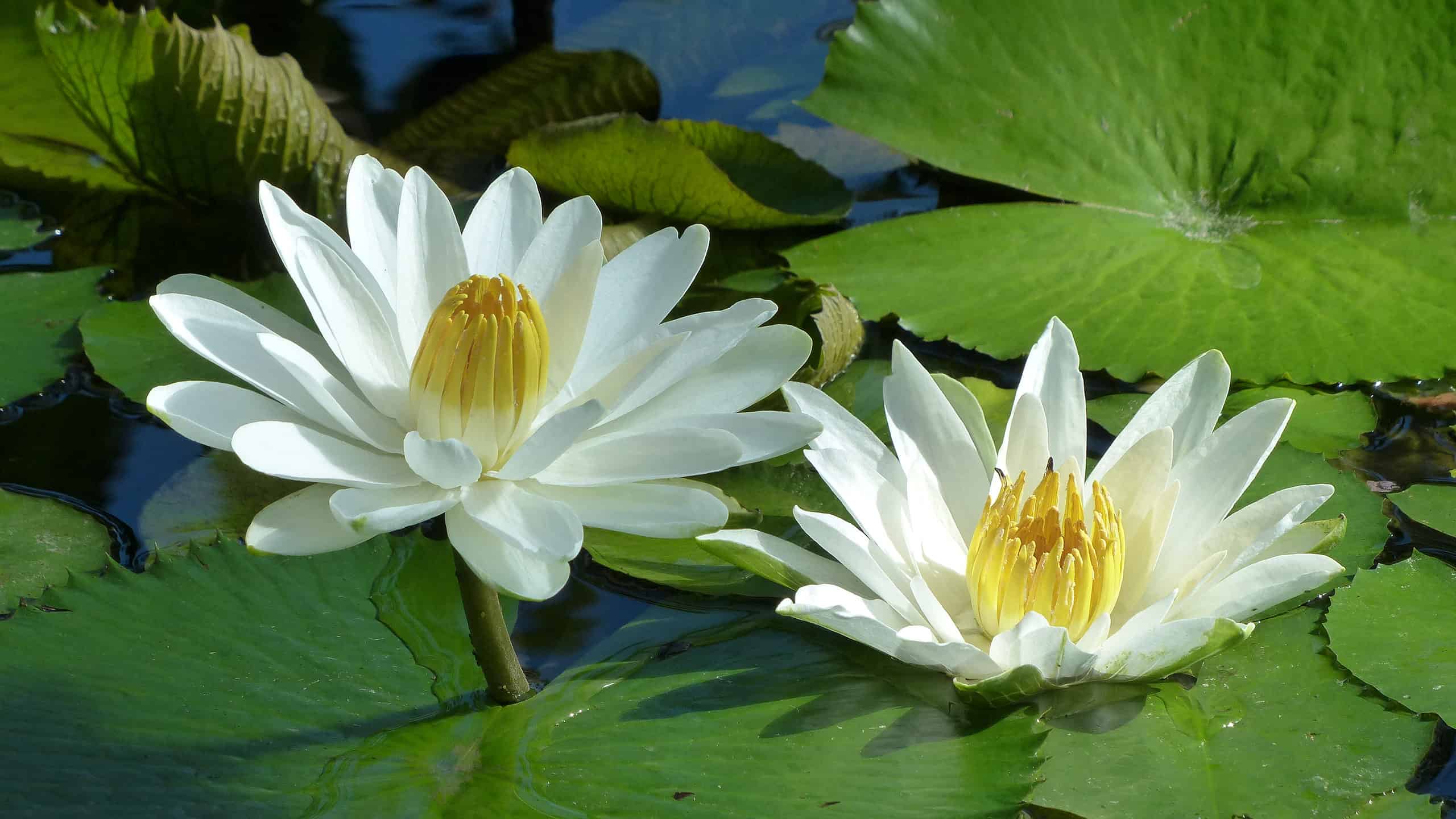There’s something enchanting about the tranquility of water gardens. The gentle sounds of water, the vibrant colors reflecting on its surface, and the harmonious coexistence of flora and fauna make them miniature paradises for us to relax and escape the hustle and bustle of modern life. If you’ve ever dreamed of creating your own oasis, a water garden may be the answer. At the heart of any thriving water garden are aquatic plants, which not only add aesthetic allure but also play vital roles in maintaining the delicate balance of this unique ecosystem. Explore 4 types of aquatic plants ideal for a water garden.
What Is a Water Garden?
A water garden is a landscape feature that combines water elements with aquatic plants. They also often include fish and other ornamental aquatic life. These gardens blend horticulture and aquaculture to create a serene outdoor space. The key elements of a water garden include:
- Water feature: This is the central element of the water garden. It includes ponds, lakes, fountains, or even small containers, depending on your available space.
- Aquatic plants: Plants are a fundamental component of a water garden. Some species root in the water while others float on its surface.
- Fish and aquatic life: Many homeowners add ornamental fish like koi or goldfish to their water gardens. Fish add visual appeal but also help manage the ecosystem by consuming insects and algae. Water gardens also support aquatic life like frogs, turtles, and water insects.
- Decorative elements: Incorporate rocks, statuary, or bridges to enhance the visual impact of your water garden.
- Water circulation and filtration: Circulation and filtration devices like pumps, filters, and aerators ensure that the water remains clear and healthy for plants and animals.

The oldest recorded water garden is the Hanging Gardens of Babylon, dating back to 600 BC, showcasing early aquaculture and horticulture.
©iStock.com/zimmytws
4 Types of Aquatic Plants Ideal for a Water Garden
Aquatic plants play an important role in water gardens and aquatic ecosystems. They add aesthetic beauty while oxygenating the water for aquatic life. Furthermore, they are natural water purifiers that absorb harmful excess nutrients. Plants also contribute to algae and temperature control, as well as erosion prevention to stabilize pond edges. Let’s explore the four main types of aquatic plants ideal for a water garden:
1. Surface Aquatic Plants
Surface aquatic plants are unique. Their roots extend into the substrate beneath the water, but their leaves and flowers float on the water’s surface, creating an enchanting layer that enhances the aesthetics of your water garden. These plants also enhance the health and balance of your aquatic ecosystem. Here’s why they are important:
- Aesthetic beauty: Surface plants often produce striking foliage and vibrant flowers that enhance the visual appeal of your water garden.
- Natural shade: The broad leaves of surface plants provide shade for the water, preventing excessive sunlight from reaching the deeper layers. This shade helps regulate water temperature and reduces the risk of excessive algae growth.
- Habitat for aquatic life: Many small fish, amphibians, and invertebrates seek refuge and breeding sites among the leaves of surface plants. They create a thriving microcosm within your garden.
- Algae control: By out-competing algae for sunlight and nutrients, surface plants contribute to the control of algae blooms, maintaining water clarity.
- Oxygenation: Like all plants, surface aquatic plants engage in photosynthesis, releasing oxygen into the water, which is essential for the health of aquatic life and water quality.
- Pollinator attraction: The flowers attract pollinators such as bees and butterflies, contributing to local biodiversity.
Types of Surface Aquatic Plants for Your Water Garden
Consider adding some of these popular types of surface plants to your water garden:
Lotus Plants (Nelumbo spp.)
Lotus plants feature large, captivating flowers on tall stems. Their cultural significance and majestic appearance make them a sought-after addition to water gardens.
Taro (Colocasia spp.)
Some varieties of taro have leaves that are rooted below the water’s surface but grow large enough to float on the water, creating an appealing display.
Water Hawthorn (Aponogeton distachyos)
Water hawthorn produces fragrant, star-shaped flowers that float on the water’s surface. The leaves and roots are usually submerged, but the flowers emerge above the waterline.
Water Lilies (Nymphaea spp.)
Water lilies produce exquisite floating blooms, which come in a variety of colors. These plants not only improve the aesthetics of your water garden but also offer shade for aquatic life beneath their leaves.
Water Poppy (Hydrocleys nymphoides)
Water poppy features bright yellow, poppy-like flowers that rest on the water’s surface. The plant is rooted in the substrate below the water but has floating blossoms.
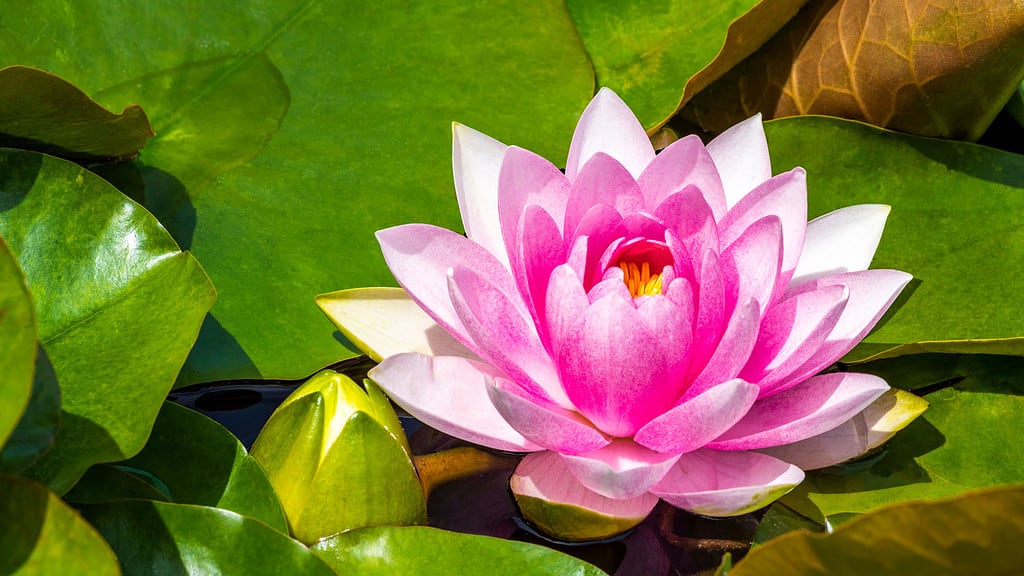
Water lilies have air spaces in their leaves and stems, which make them buoyant and able to float on the water’s surface.
©Papp Szabolcs/Shutterstock.com
2. Submerged Aquatic Plants
Submerged aquatic plants inhabit the lower regions of the aquatic environment below the water’s surface. They are a critical element to effective water gardens and offer a range of benefits, including:
- Water clarity: Submerged aquatic plants help maintain water clarity. They compete with algae for nutrients, reducing the excessive growth of unwanted algae. As they absorb nutrients, they also prevent water from becoming murky and maintain a crystal-clear appearance.
- Oxygenation: This process is essential for the health of fish and other aquatic organisms in your water garden. It ensures a well-balanced and oxygen-rich environment.
- Nutrient uptake: These plants act as natural filters, absorbing excess nutrients such as nitrates and phosphates. They improve water quality and help prevent eutrophication, a common problem in stagnant or nutrient-rich waters.
- Habitat and protection: Submerged aquatic plants provide a safe place for various aquatic organisms. Fish, invertebrates, and young amphibians often find shelter and breeding sites among their submerged leaves. This contributes to biodiversity within your water garden.
- Erosion control: The root systems anchor the soil at the bottom of your water garden. This is especially important for preventing erosion and maintaining your garden’s structure over time.
Types of Submerged Aquatic Plants for Your Water Garden
Here are some common submerged aquatic plant varieties you can add to your garden:
American Waterweed (Elodea canadensis)
American waterweed is a common submerged plant that oxygenates the water and assists in nutrient absorption, thereby improving water quality.
Anacharis (Elodea canadensis)
Anacharis is a versatile oxygenator, releasing oxygen during photosynthesis while absorbing carbon dioxide. It plays a crucial role in maintaining water quality by reducing nutrient levels and inhibiting algae growth.
Cabomba (Cabomba caroliniana)
With its finely divided foliage, the cabomba is a popular choice for water gardens. It provides oxygenation, nutrient removal, and shelter for fish and aquatic invertebrates.
Cryptocoryne (Cryptocoryne spp.)
Cryptocoryne plants feature attractive, broad leaves that add visual interest to your underwater landscape. They are effective nutrient absorbers and help maintain a balanced aquatic ecosystem.
Eelgrass (Vallisneria spp.)
Eelgrass, also known as tape grass, features long, ribbon-like leaves that sway gracefully in the water. It is excellent at absorbing excess nutrients, contributing to water clarity, and also providing shelter for fish and invertebrates.
Fanwort (Cabomba caroliniana)
Fanwort is a submerged plant that also has finely divided leaves. It enhances the visual appeal of your water garden and also contributes to water clarity and the well-being of aquatic organisms.
Hornwort (Ceratophyllum demersum)
Hornwort is a fast-growing, bushy plant with feathery foliage. It oxygenates the water, absorbs nutrients, and provides a habitat for small aquatic organisms. Additionally, its rapid growth helps control algae and maintain water quality.
Mermaid Weed (Proserpinaca palustris)
Mermaid weed has finely dissected fern-like leaves. It serves as a nutrient sponge, helping to maintain clear water and promoting the health of aquatic life.
Rotala (Rotala spp.)
Rotala is an attractive submerged plant with delicate, pinnately divided leaves. It is valued for its aesthetic appeal and contributes to water quality by absorbing nutrients.
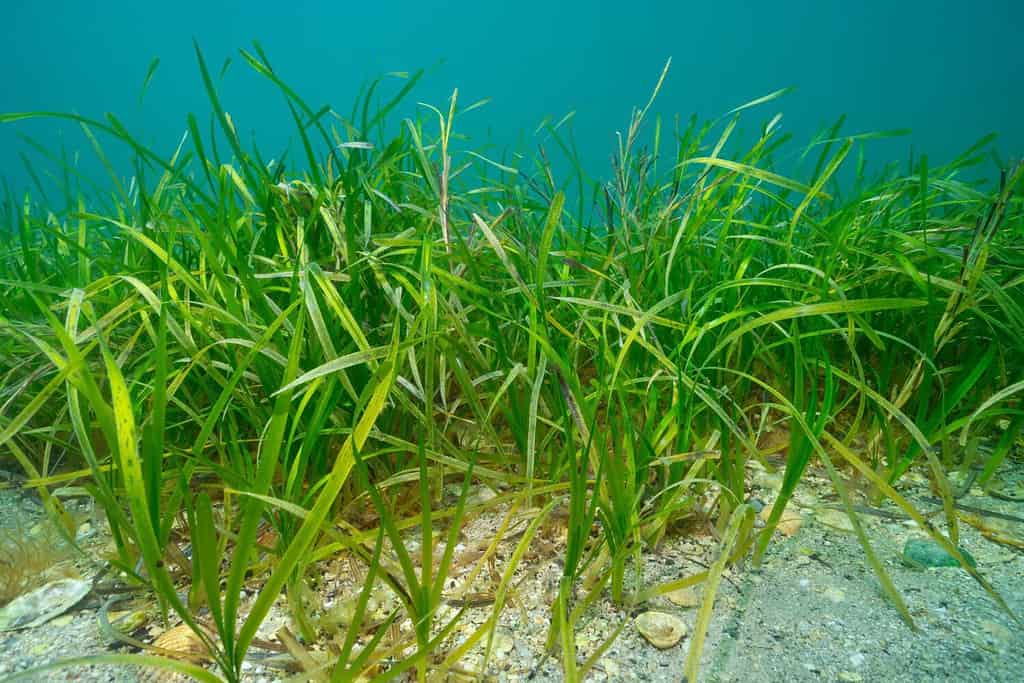
Eelgrass has an impressive growth rate, with some meadows expanding by up to 3.5 feet per year.
©Damsea/Shutterstock.com
3. Floating Aquatic Plants
These plants are similar to surface aquatic plants. However, they have one fundamental difference–their roots do not enter the substrate. Floating aquatic plants float on the water’s surface while their roots dangle below in the water. Benefits of floating plants include:
- Water filtration: Floating aquatic plants act as filters by absorbing excess nutrients, including nitrates and phosphates, from the water. This nutrient uptake helps prevent the overgrowth of algae and also maintains water clarity.
- Algae control: They create shade that limits the amount of sunlight reaching the water’s surface. This reduction in sunlight can help control and inhibit the growth of unsightly and problematic algae, keeping your water garden clear and clean.
- Oxygenation: They undergo photosynthesis, releasing oxygen into the water. This oxygenation is essential for the health of fish and other aquatic organisms.
- Habitat: Floating plants provide shelter and breeding sites for various aquatic organisms. Fish, invertebrates, and amphibians hide among the floating leaves and roots.
- Temperature control: The shade they create helps regulate water temperature. This is particularly beneficial during hot summer months, preventing overheating in your water garden.
Types of Floating Aquatic Plants for Your Water Garden
Examples of floating aquatic plants include:
Azolla (Azolla spp.)
Azolla, often called mosquito fern, is a small, floating fern that can cover the water’s surface. It’s a nitrogen-fixing plant that improves water quality and also serves as a habitat for invertebrates.
Duckweed (Lemna minor)
Duckweed is a tiny, free-floating plant that can quickly cover the water’s surface. It acts as a natural water purifier and also provides a surface habitat for small aquatic life.
Salvinia (Salvinia spp.)
Salvinia is a floating fern with distinctive, air-filled leaves that keep it buoyant. It offers shade, controls evaporation, and can help prevent algae growth.
Water Hyacinth (Eichhornia crassipes)
This floating plant boasts attractive lavender or blue flowers and glossy, rounded leaves. Water hyacinth also helps control algae and provides shelter for aquatic creatures.
Water Lettuce (Pistia stratiotes)
This unique cultivar forms rosettes of velvety leaves that float on the water’s surface. Water lettuce’s root system helps absorb excess nutrients, aiding in water purification.
Water Snowflake (Nymphoides spp.)
Featuring delicate, star-shaped flowers and floating leaves, water snowflakes add a touch of elegance to your water garden while providing shade for aquatic life.
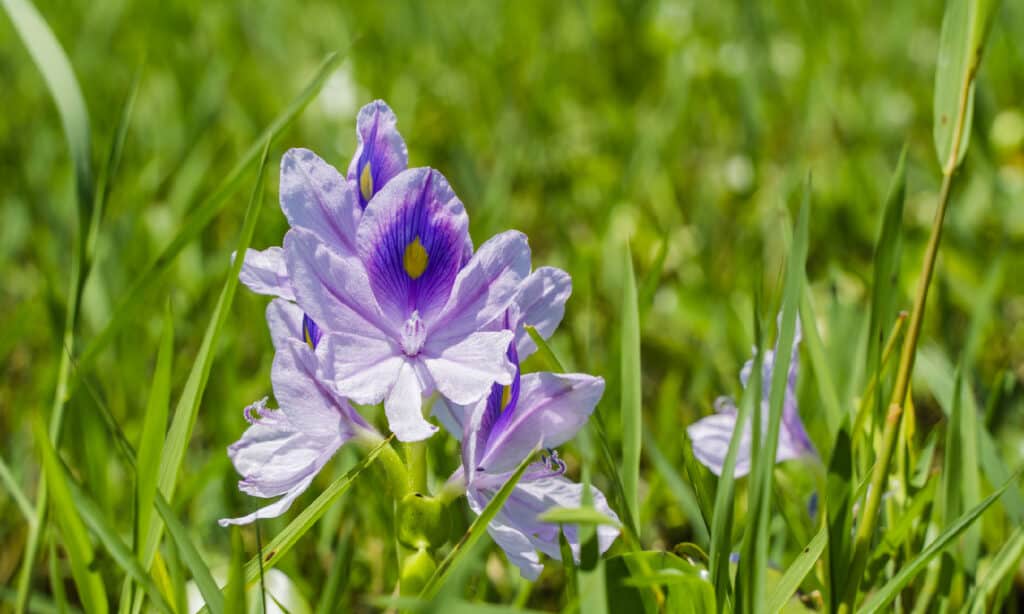
Water hyacinth is a prolific grower. It can double its population size in as little as 12 days under optimal conditions, making it a challenge to control in some environments.
©iStock.com/Shai-Halud
4. Marginal Aquatic Plants
Also known as bog plants, marginal aquatic plants grow at the water’s edge in water gardens, including large ponds. They thrive in the transition zone between water and land. Additionally, their roots are always partially or fully submerged in rich, moist soil. Marginal aquatic plants offer several benefits, including:
- Aesthetics: Marginal plants produce ornamental foliage, vibrant flowers, and striking architectural features. They provide visual interest and enhance the overall aesthetics of your water garden.
- Filtration: Their roots act as natural filters, helping to purify the water by absorbing excess nutrients and trapping sediment. This filtration contributes to water clarity and quality.
- Erosion control: The extensive root systems of marginal plants help stabilize the shoreline by preventing erosion and keeping the edges of your water garden intact.
- Habitat: Marginal plants provide important habitat and nesting sites for various wildlife, including frogs, birds, and insects.
- Attract insects: Some marginal plants, like cattails and rushes, attract insects, making them an excellent choice if you want to encourage dragonflies and other beneficial insects in your water garden.
Pro tip: Marginal aquatic plants also work great in various landscape settings, like flooded areas.
Types of Marginal Aquatic Plants for Your Water Garden
Popular cultivars of marginal aquatic plants include:
Bogbean (Menyanthes trifoliata)
Bogbean produces distinctive three-part leaves and delicate white or pink flowers. It prefers moist conditions and is an excellent choice for marginal planting.
Cattails (Typha spp.)
Cattails are tall, reed-like plants with distinctive cylindrical flower spikes. Find them growing at the water’s edge, providing both beauty and wildlife habitats.
Irises (Iris spp.)
Irises, including the popular “Louisiana iris,” add vibrant color with their elegant flowers and are often planted at the water’s edge.
Marsh Marigold (Caltha palustris)
Marsh marigold produces bright yellow, buttercup-like flowers. It thrives in moist soil along the shoreline.
Pickerelweed (Pontederia cordata)
Pickerelweed features attractive, arrowhead-shaped leaves and spikes of blue or violet flowers. It is a favorite of pollinators and birds.
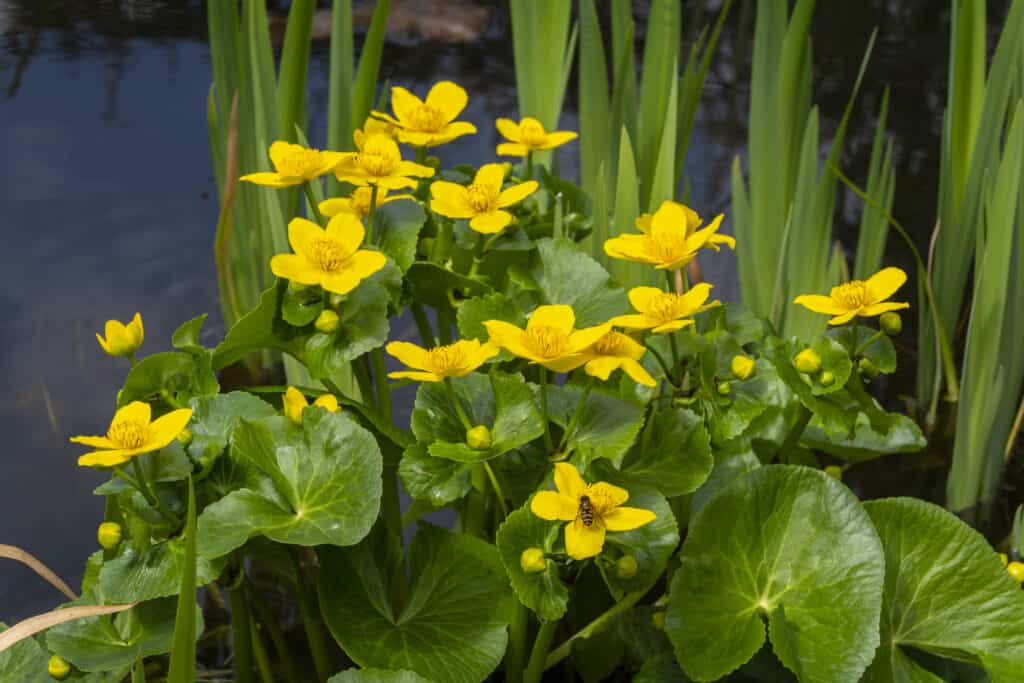
Marsh marigold is often called “kingcup” in Europe. It’s one of the first wildflowers to brighten wetland areas in the spring.
©iStock.com/senatorek
Maintenance and Care
Maintaining and caring for your aquatic plants is essential to ensure their health and the overall balance of your garden’s ecosystem. Most aquatic plants are low-maintenance, but here are some general guidelines for their maintenance and care:
- Choose plants that are suitable for your region and water garden conditions and ensure you have the right type of plants for your water garden.
- Plant submerged and marginal plants at the appropriate water depth, ensuring they receive adequate sunlight. Additionally, use aquatic planting containers or pots with aquatic soil for planting and space plants according to their growth habits to prevent overcrowding.
- Monitor water quality parameters, such as pH, ammonia, nitrate, and phosphate levels, to ensure they are within the appropriate range for your plants. Furthermore, perform regular water changes to maintain water quality, depending on your water garden setup.
- Some aquatic plants benefit from fertilization. Use specialized aquatic plant fertilizers sparingly, following the product instructions.
- Regularly trim and thin plants to prevent overcrowding and to maintain desired aesthetics. Additionally, remove dead or decaying plant material to prevent water quality issues.
- Watch for signs of pests, such as aphids, snails, or plant diseases. Treat infestations promptly with appropriate measures, such as introducing natural predators or using approved treatments.
- For regions with cold winters, consider overwintering your aquatic plants. Some may need to be moved to deeper water, while others may be brought indoors.
- Marginal plants benefit from division to maintain vigor and control growth. Divide plants as needed, typically every few years.
- If you have fish, protect your plants from being uprooted or damaged by using floating plant protectors or weighted pots.
Creating a Living Water Garden Ecosystem
There is a diverse range of aquatic plants to enhance your water garden. Understanding the distinct categories, including the difference between floating and surface aquatic plants is the crucial first step in creating a harmonious and thriving aquatic ecosystem. Each category plays a unique role in maintaining water quality, providing habitat for aquatic life, and elevating the aesthetic appeal of your water garden.
Summary: 4 Types of Aquatic Plants for Water Gardens
| Number | Aquatic Plant Type |
|---|---|
| 1 | Surface Aquatic Plants |
| 2 | Submerged Aquatic Plants |
| 3 | Floating Aquatic Plants |
| 4 | Marginal Aquatic Plants |
Thank you for reading! Have some feedback for us? Contact the AZ Animals editorial team.

